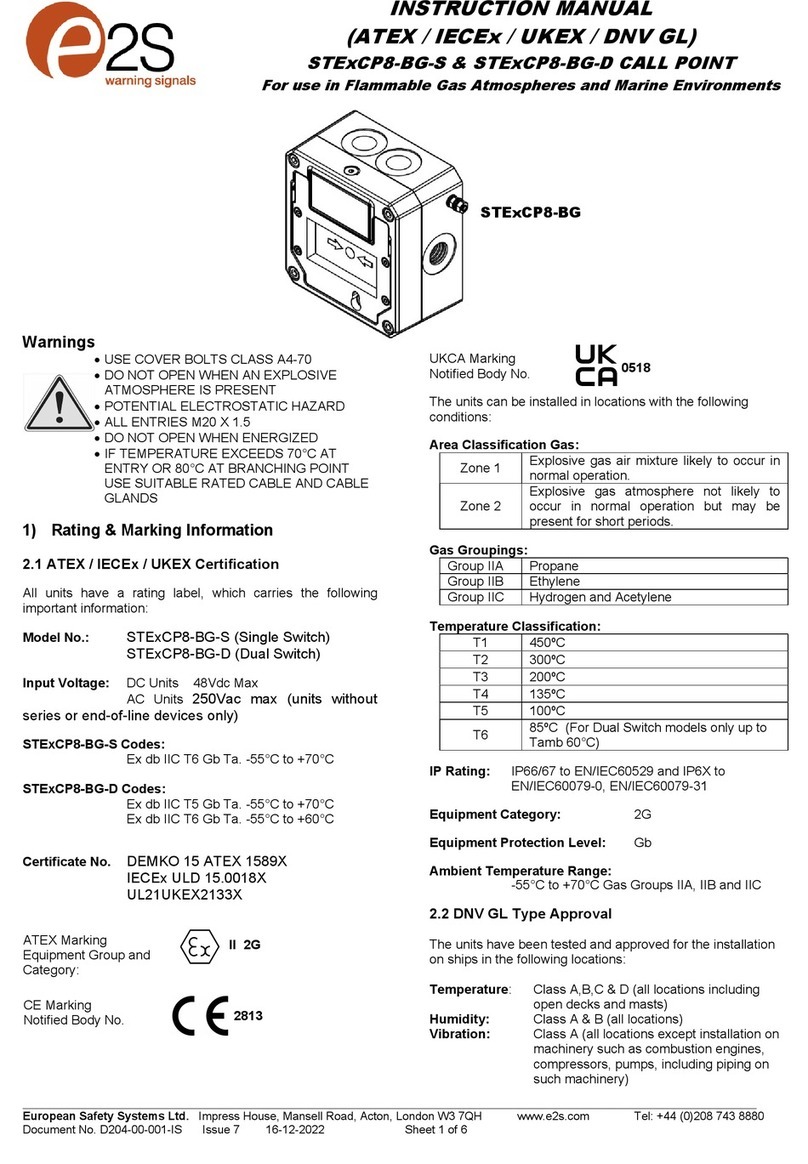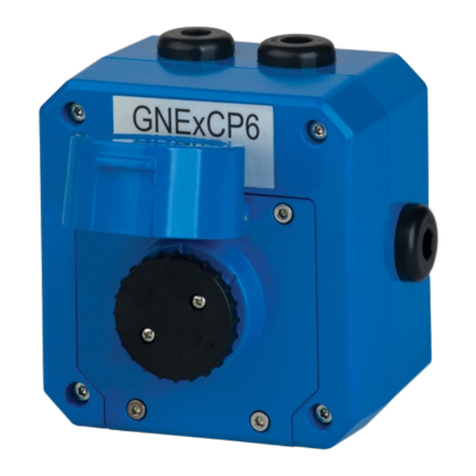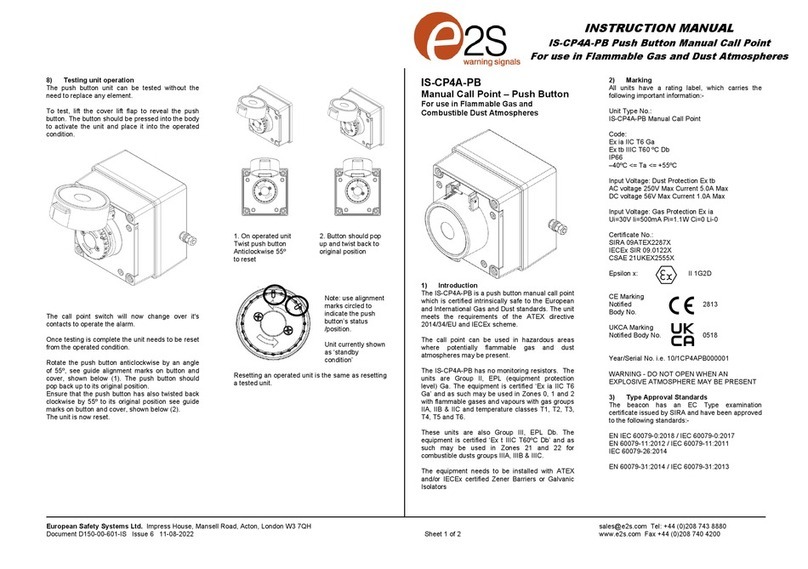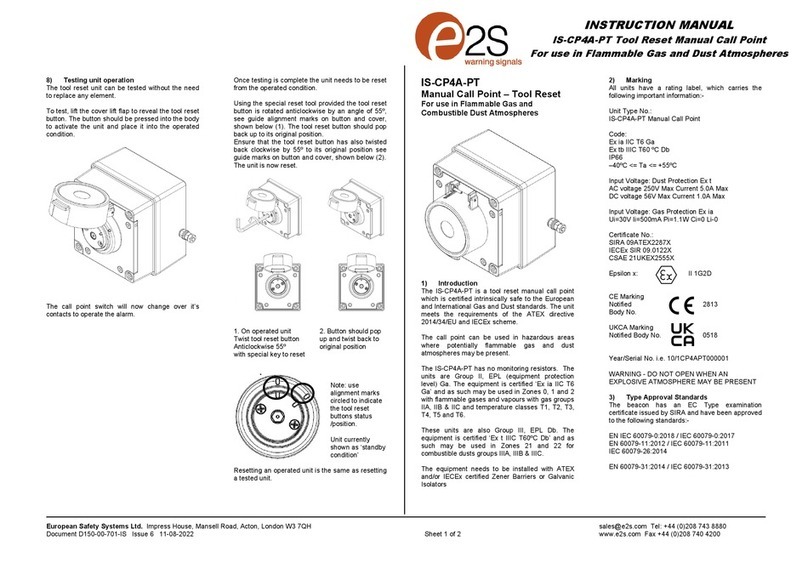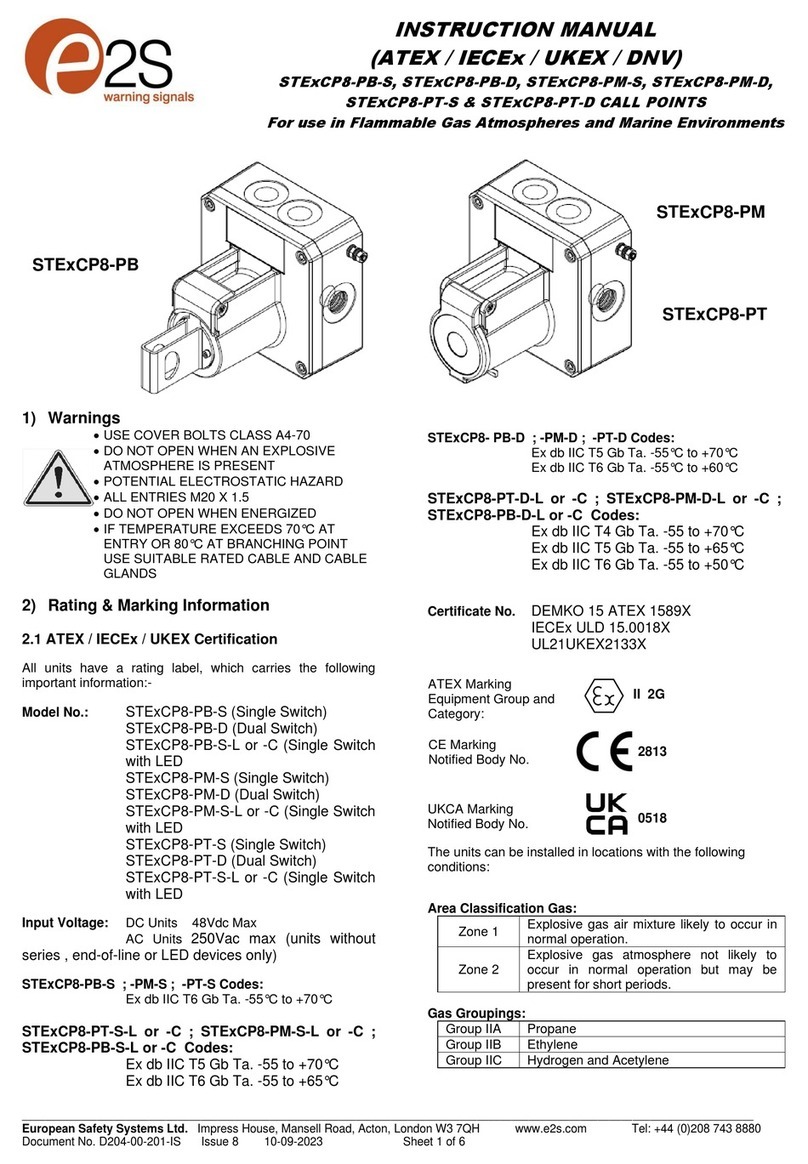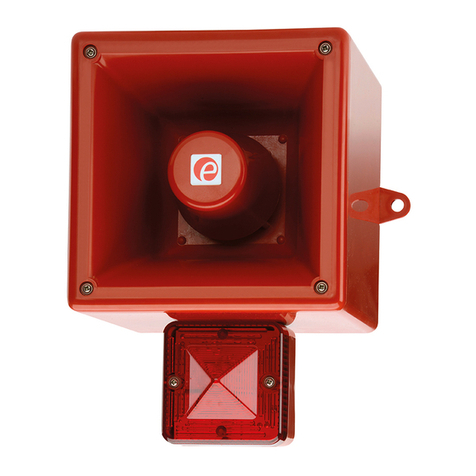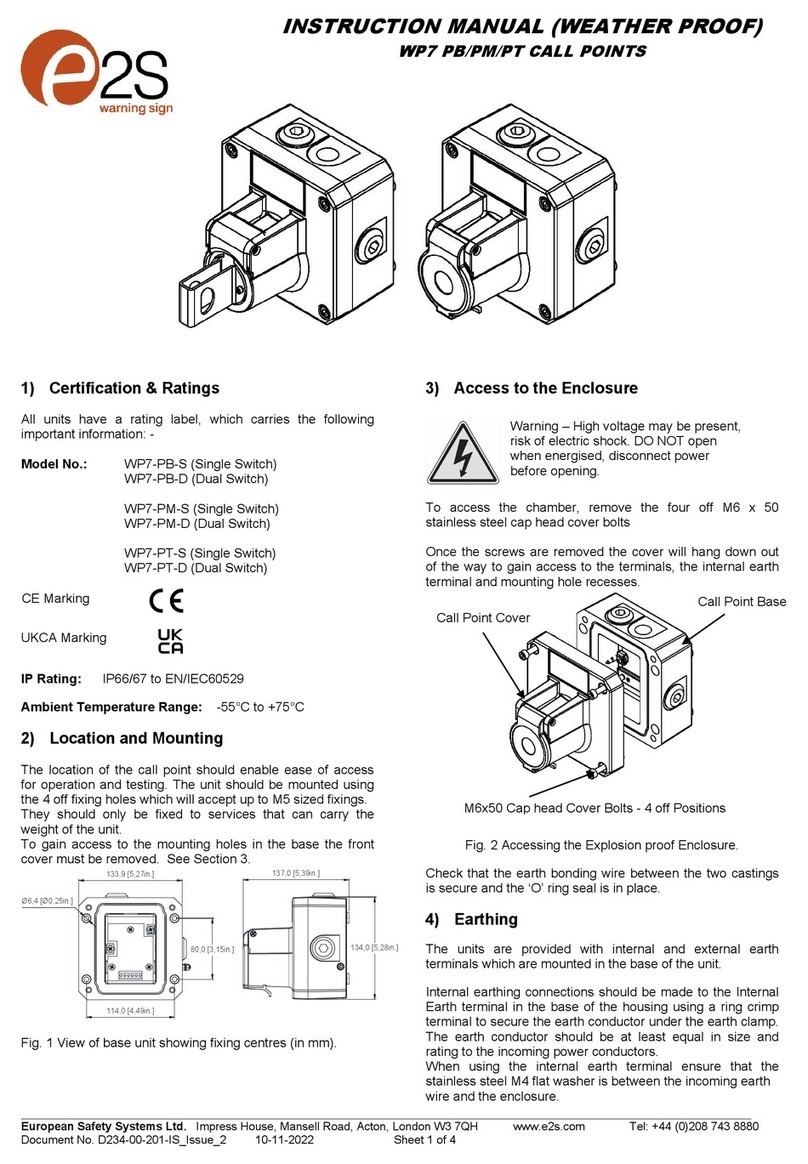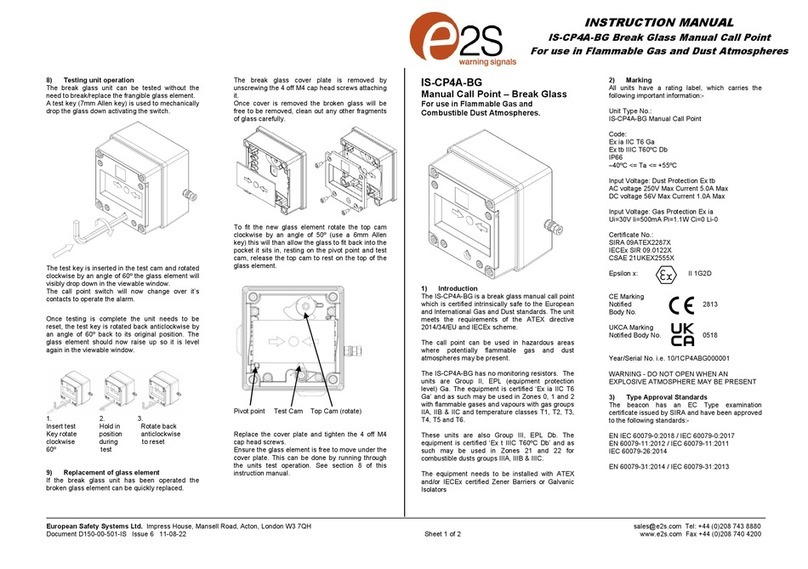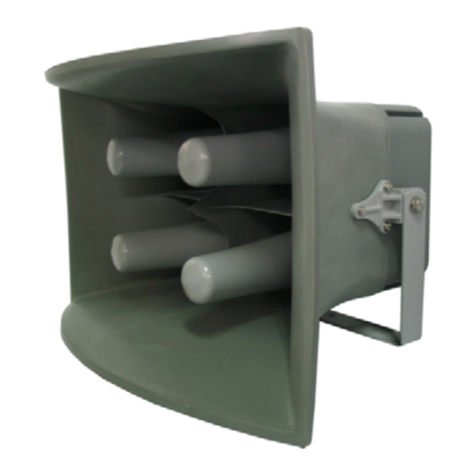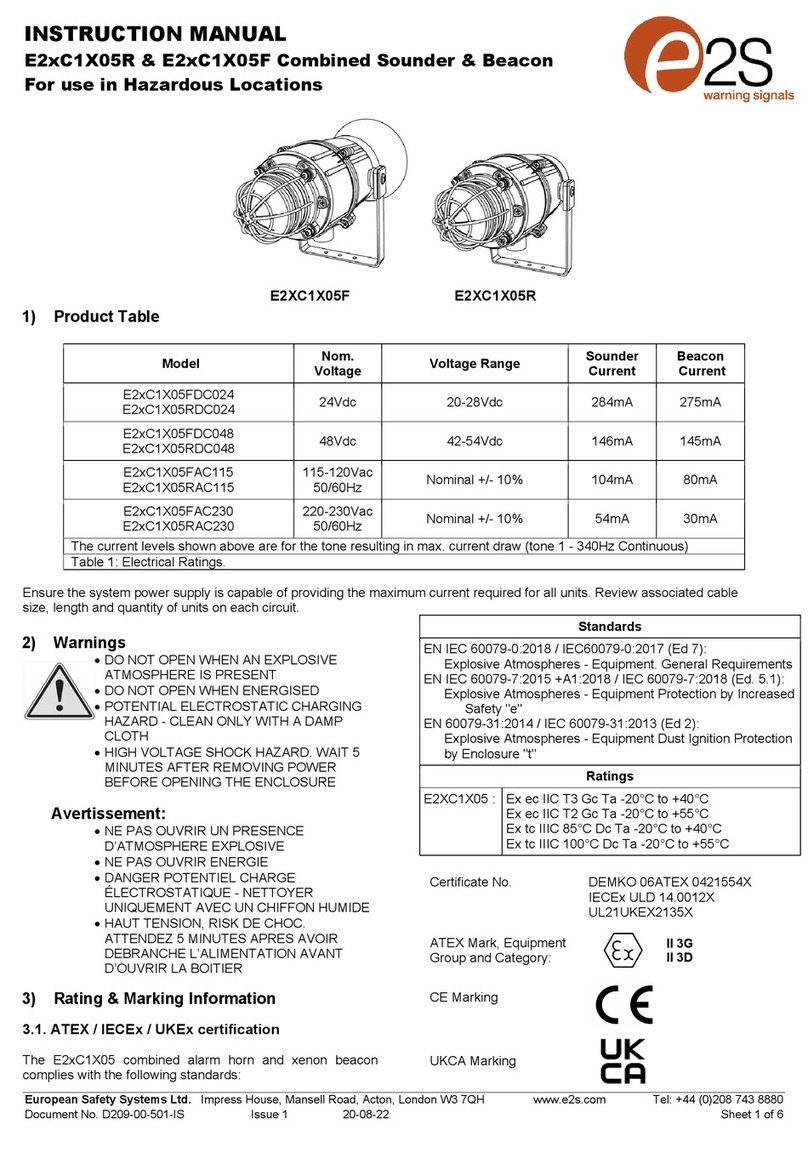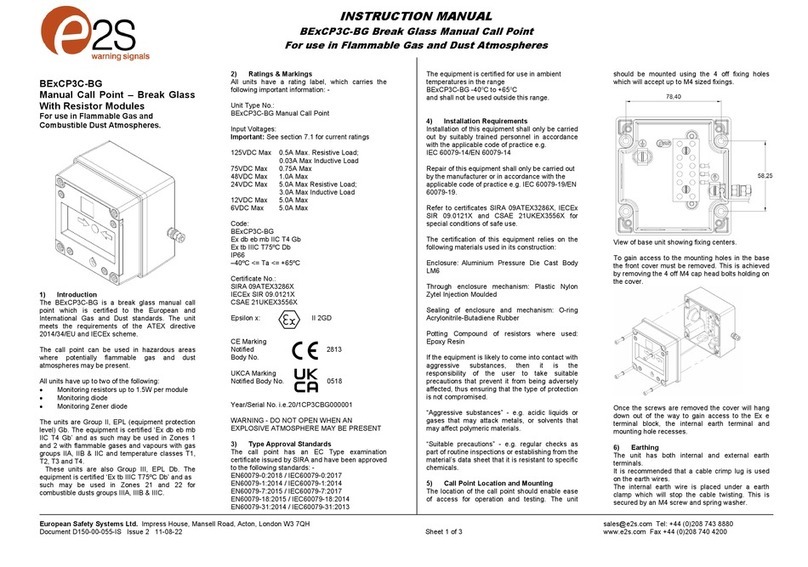E2S BExCP3A-BG User manual

European Safety Systems Ltd. Impress House, Mansell Road, Acton, London W3 7QH sales@e2s.com Tel: +44 (0)208 743 8880
Document D150-00-001-IS Issue 4 31-01-20 Sheet 1 of 3 www.e2s.com Fax +44 (0)208 740 4200
BExCP3A-BG
Manual Call Point – Break Glass
For use in Flammable Gas and
Combustible Dust Atmospheres.
1) Introduction
The BExCP3A-BG is a break glass manual call
point which is certified to the European and
International Gas and Dust standards. The unit
meets the requirements of the ATEX directive
2014/34/EU and IECEx scheme.
The call point can be used in hazardous areas
where potentially flammable gas and dust
atmospheres may be present.
2) Ratings & Markings
All units have a rating label, which carries the
following important information: -
Unit Type No.:
BExCP3A-BG Manual Call Point
Input Voltage:
AC voltage 250V Max Current 5.0A Max
DC voltage 75V Max Current 0.75A Max
DC voltage 50V Max Current 1.0A Max
DC voltage 30V Max Current 5.0A Max Resistive
Load; Inductive Load 3.0A Max
DC voltage 12V Max Current 5.0A Max
Code:
Ex db eb IIC T6 Gb
Ex tb IIIC T75 ºC Db
IP66
–40ºC <= Ta <= +70ºC
Certificate No.:
SIRA 09ATEX3286X
IECEx SIR 09.0121X
Epsilon x: II 2GD
CE Marking
Notified body No. 2813
Year/Serial No. i.e. 20/1CP3ABG000001
WARNING - DO NOT OPEN WHEN AN
EXPLOSIVE ATMOSPHERE MAY BE PRESENT
3) Type Approval Standards
The call point has an EC Type examination
certificate issued by SIRA and have been approved
to the following standards: -
EN60079-0:2018 / IEC60079-0:2017
EN60079-1:2014 / IEC60079-1:2014
EN60079-7:2015 / IEC60079-7:2017
EN60079-18:2015 / IEC60079-18:2014
EN60079-31:2014 / IEC60079-31:2013
The equipment is certified for use in ambient
temperatures in the range -40oC to +70oC and shall
not be used outside this range.
4) Installation Requirements
Installation of this equipment shall only be carried
out by suitably trained personnel in accordance
with the applicable code of practice e.g.
IEC 60079-14/EN 60079-14 and IEC 61241-14/EN
61241-14.
Repair of this equipment shall only be carried out
by the manufacturer or in accordance with the
applicable code of practice e.g. IEC 60079-19/EN
60079-19.
The certification of this equipment relies on the
following materials used in its construction:
Enclosure: Aluminium Pressure Die Cast Body
LM6
Through enclosure mechanism: Plastic Nylon Zytel
Injection Moulded
Sealing of enclosure and mechanism: O-ring
Acrylonitrile-Butadiene Rubber
Potting Compound of resistors where used: Epoxy
Resin
If the equipment is likely to come into contact with
aggressive substances, then it is the responsibility
of the user to take suitable precautions that prevent
it from being adversely affected, thus ensuring that
the type of protection is not compromised.
“Aggressive substances” - e.g. acidic liquids or
gases that may attack metals, or solvents that may
affect polymeric materials.
“Suitable precautions” - e.g. regular checks as part
of routine inspections or establishing from the
material’s data sheet that it is resistant to specific
chemicals.
Leads connected to the terminals shall be insulated
for the appropriate voltage and this insulation shall
extend to within 1mm of the metal of the terminal
throat. They shall only be installed and wired with
cable in an ambient temperature of -10°C to +80°C
All terminal screws, used or unused, shall be
tightened down to between 0.5 Nm and 0.7 Nm
Refer to certificates SIRA 09ATEX3286X and
IECEx SIR 09.0121X for special conditions of safe
use.
5) Call Point Location and Mounting
The location of the call point should enable ease of
access for operation and testing. The unit should
be mounted using the 4 off fixing holes which will
accept up to M4 sized fixings.
View of base unit showing fixing centres (in mm).
To gain access to the mounting holes in the base
the front cover must be removed. This is achieved
by removing the 4 off M4 cap head bolts holding on
the cover.
Once the screws are removed the cover will hang
down out of the way to gain access to the Ex e
terminal block, the internal earth terminal and
mounting hole recesses.
INSTRUCTION MANUAL
BExCP3A-BG Break Glass Manual Call Point
Fo
r
us
e
i
n
Flammabl
e
Ga
s
and
Dus
t
Atmos
p
here
s

European Safety Systems Ltd. Impress House, Mansell Road, Acton, London W3 7QH sales@e2s.com Tel: +44 (0)208 743 8880
Document D150-00-001-IS Issue 4 31-01-20 Sheet 2 of 3 www.e2s.com Fax +44 (0)208 740 4200
Unit in ‘Standby condition’
unoperated
Terminal +(2,3) & (6) switch
contacts closed
Terminals +(2,3) & -(4,5)
switch contacts o
p
en
Unit in ‘Operated condition’
(broken glass)
microswitch contacts changed over
Terminal +(2,3) & (6) switch contacts
open
Terminals +(2,3) & -(4,5) switch
contacts closed
Unit in ‘Operated condition’
(broken glass)
microswitch contacts changed over
Terminal +(1) & (3)
Terminal +(4) & (6) switch contacts
open
Terminals +(1) & -(2)
Terminals +(4) & -(5) switch
contacts closed
Unit in ‘Standby condition’
unoperated
Terminal +(1) & (3)
Terminal +(4) & (6) switch
contacts closed
Terminals+ (1) &- (2)
Terminals +(4) & -(5) switch
contacts open
6) Earthing
The unit has both internal and external earth
terminals. It is recommended that a cable crimp
lug is used on the earth wires. The internal earth
wire is placed under a earth clamp which will stop
the cable twisting. This is secured by an M4
screw and spring washer. The external earth lug
should be located between the two M5 washers
provided and securely locked down with the M5
spring washer and two locknuts.
7) Cable connections
There are 3 off cable entries for M20x1.5 Ex e
approved cable glands or stopping plugs
The unit can be wired in a number of different ways
depending whether normally open or normally
closed contacts are required.
Single microswitch units:
Double microswitch units:
When wiring to Increased Safety terminal
enclosures, you are only permitted to connect one
wire into each way on the terminal block, unless a
pair of wires are crimped into a suitable ferrule.
8) Testing unit operation
The break glass unit can be tested without the
need to break/replace the frangible glass element.
A test key is used to mechanically drop the glass
down activating the switch.
The test key is inserted in the test cam and rotated
clockwise by an angle of 60º the glass element will
visibly drop down in the viewable window.
The call point switch will now change over its
contacts to operate the alarm.
Once testing is complete the unit needs to be
reset, the test key is rotated back anticlockwise by
an angle of 60º back to its original position. The
glass element should now raise up so it is level
again in the viewable window.
1. 2. 3.
Insert test Hold in Rotate back
Key rotate position anticlockwise
clockwise during to reset
60º test
9) Replacement of glass element
If the break glass unit has been operated the
broken glass element can be quickly replaced.
The break glass cover plate is removed by
unscrewing the 4 off M4 cap head screws attaching
it.
Once the cover is removed the broken glass will be
free to be removed, clean out any other fragments
of glass carefully.
To fit the new glass element rotate the top cam
clockwise by an angle of 50º (use a 6mm Allen
key) this will than allow the glass to fit back into the
pocket it sits in, resting on the pivot point and test
cam, release the top cam to rest on the top of the
glass element.
Pivot point Test Cam Top Cam (rotate)
Replace the cover plate and tighten the 4 off M4
cap head screws.
Ensure the glass element is free to move under the
cover plate. This can be done by running through
the units test operation. See section 8 of this
instruction manual.
Internal Earth
terminal
Ex e terminal
block
External
Earth Stud

European Safety Systems Ltd. Impress House, Mansell Road, Acton, London W3 7QH sales@e2s.com Tel: +44 (0)208 743 8880
Document D150-00-001-IS Issue 4 31-01-20 Sheet 3 of 3 www.e2s.com Fax +44 (0)208 740 4200
10) SIL 2 Reliability Data
Reliability and Functional safety IEC/EN61508
which has been assessed and is considered
suitable for use in low demand safety function:
• Random Hardware Failures and Systematic
Failures (route 2H)
• As an unvoted item (i.e. hardware fault tolerance
of 0) at SIL 2
The product was assessed against failure modes:
• Failure to close a contact when the call point is
struck with specified force
• Failure to open a contact when the call point is
struck with specified force
• Spurious output despite no input
Integrityinrespectof
failuretoclose
SIL2
TotalFailurerate 0.133pmh
“hazardous”failure
rate(revealed)
0pmh
“hazardous”failure
rate(unrevealed)
0.1pmh
“safe”failurerate
(revealed)
0.033pmh
“safe”failurerate
(unrevealed)
0
DiagnosticCoverage 99%
Systemtype A
HardwareFault
Tolerance
0
SafeFailureFraction >99%
PFD(hazardous
failure)
1.25x10‐3
ProofTestInterval Upto1year
Other manuals for BExCP3A-BG
1
Other E2S Safety Equipment manuals
Popular Safety Equipment manuals by other brands

Lanex
Lanex PB-20 instruction manual

SKYLOTEC
SKYLOTEC ANCHOR ROPES Instructions for use

Besto
Besto Buoyancy Aid 50N Instructions for use

TEUFELBERGER
TEUFELBERGER NODUS Manufacturer's information and instructions for use

Troy Lee Designs
Troy Lee Designs Tbone Product owners manual

Innova
Innova Xtirpa Instruction and safety manual

bolle SAFETY
bolle SAFETY B810 quick start guide

SHENZHEN FANHAI SANJIANG ELECTRONICS
SHENZHEN FANHAI SANJIANG ELECTRONICS A9060T instruction manual

Hiltron security
Hiltron security POWER8E Installation and use manual

Salewa
Salewa MTN SPIKE user manual

Hatco
Hatco B-950P installation guide

Sitec
Sitec TX MATIC operating manual
